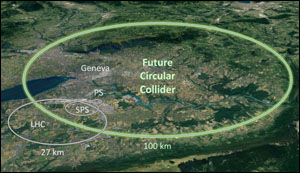CERN lays out vision for next-generation particle collider
16. 1. 2019 | Phys.org | www.phys.org
Scientists behind the world's largest atom smasher have laid out their multibillion-euro vision to build an even bigger one, in hopes of unlocking even more secrets of matter and the universe in the coming decades.
Officials at CERN, the European Organization for Nuclear Research, presented their study for a "Future Circular Collider" inside a 100-kilometer (62-mile) circumference tunnel that could start operating in 2040. It would sit next to the current 27-kilometer (17-mile) circumference Large Hadron Collider near Geneva, which is perhaps best known for helping confirm the subatomic Higgs boson in 2012.

Officials hope for a decision by CERN's 22 member states within the next few years about the project that would debut with an electron-positron collider at an estimated cost of 9 billion euros ($10.25 billion). A second phase would involve a superconducting proton machine in the same tunnel, at a cost of about 15 billion euros more. That machine could start operation in the late 2050s. Ultimately, the FCC would include a superconducting proton accelerator ring with energy of up to 100 tera electron volts, compared with a maximum 17 TeV in the current collider.
Read more at Phys.org
Image Credit: CERN
-jk-




